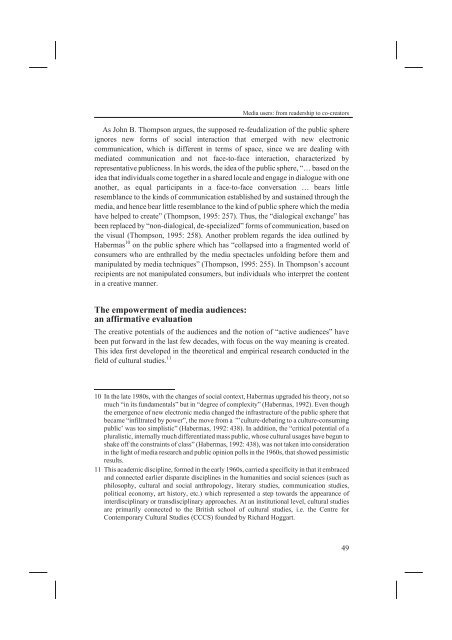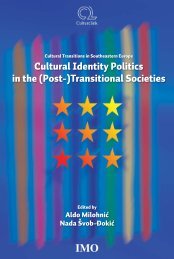D:\Documents and Settings\Ana\My Documents\Biserka-knjiga ...
D:\Documents and Settings\Ana\My Documents\Biserka-knjiga ...
D:\Documents and Settings\Ana\My Documents\Biserka-knjiga ...
Create successful ePaper yourself
Turn your PDF publications into a flip-book with our unique Google optimized e-Paper software.
As John B. Thompson argues, the supposed re-feudalization of the public sphere<br />
ignores new forms of social interaction that emerged with new electronic<br />
communication, which is different in terms of space, since we are dealing with<br />
mediated communication <strong>and</strong> not face-to-face interaction, characterized by<br />
representative publicness. In his words, the idea of the public sphere, “… based on the<br />
idea that individuals come together in a shared locale <strong>and</strong> engage in dialogue with one<br />
another, as equal participants in a face-to-face conversation … bears little<br />
resemblance to the kinds of communication established by <strong>and</strong> sustained through the<br />
media, <strong>and</strong> hence bear little resemblance to the kind of public sphere which the media<br />
have helped to create” (Thompson, 1995: 257). Thus, the “dialogical exchange” has<br />
been replaced by “non-dialogical, de-specialized” forms of communication, based on<br />
the visual (Thompson, 1995: 258). Another problem regards the idea outlined by<br />
Habermas 10 on the public sphere which has “collapsed into a fragmented world of<br />
consumers who are enthralled by the media spectacles unfolding before them <strong>and</strong><br />
manipulated by media techniques” (Thompson, 1995: 255). In Thompson’s account<br />
recipients are not manipulated consumers, but individuals who interpret the content<br />
in a creative manner.<br />
The empowerment of media audiences:<br />
an affirmative evaluation<br />
Media users: from readership to co-creators<br />
The creative potentials of the audiences <strong>and</strong> the notion of “active audiences” have<br />
been put forward in the last few decades, with focus on the way meaning is created.<br />
This idea first developed in the theoretical <strong>and</strong> empirical research conducted in the<br />
field of cultural studies. 11<br />
10 In the late 1980s, with the changes of social context, Habermas upgraded his theory, not so<br />
much “in its fundamentals” but in “degree of complexity” (Habermas, 1992). Even though<br />
the emergence of new electronic media changed the infrastructure of the public sphere that<br />
became “infiltrated by power”, the move from a ”’culture-debating to a culture-consuming<br />
public’ was too simplistic” (Habermas, 1992: 438). In addition, the “critical potential of a<br />
pluralistic, internally much differentiated mass public, whose cultural usages have begun to<br />
shake off the constraints of class” (Habermas, 1992: 438), was not taken into consideration<br />
in the light of media research <strong>and</strong> public opinion polls in the 1960s, that showed pessimistic<br />
results.<br />
11 This academic discipline, formed in the early 1960s, carried a specificity in that it embraced<br />
<strong>and</strong> connected earlier disparate disciplines in the humanities <strong>and</strong> social sciences (such as<br />
philosophy, cultural <strong>and</strong> social anthropology, literary studies, communication studies,<br />
political economy, art history, etc.) which represented a step towards the appearance of<br />
interdisciplinary or transdisciplinary approaches. At an institutional level, cultural studies<br />
are primarily connected to the British school of cultural studies, i.e. the Centre for<br />
Contemporary Cultural Studies (CCCS) founded by Richard Hoggart.<br />
49



